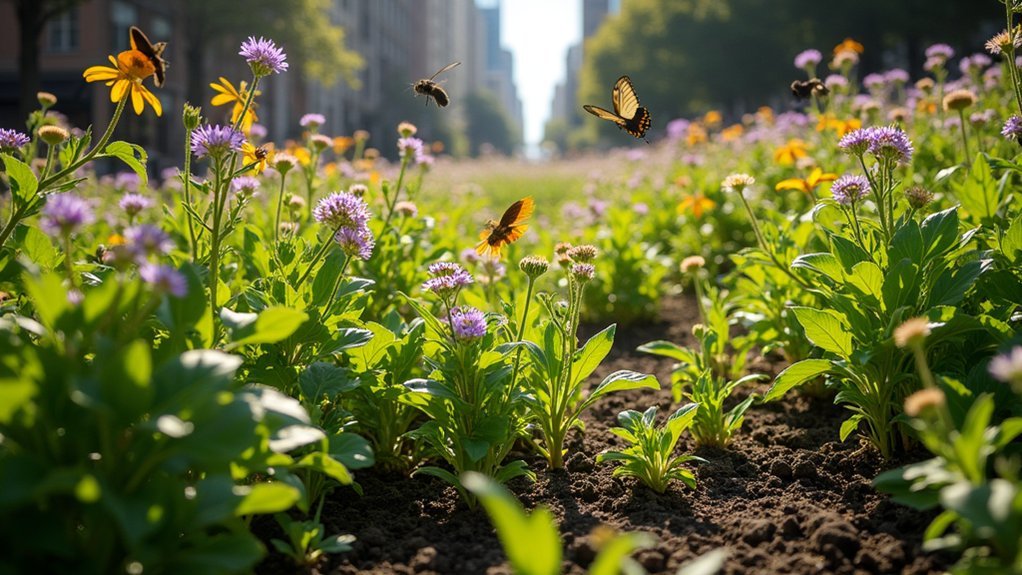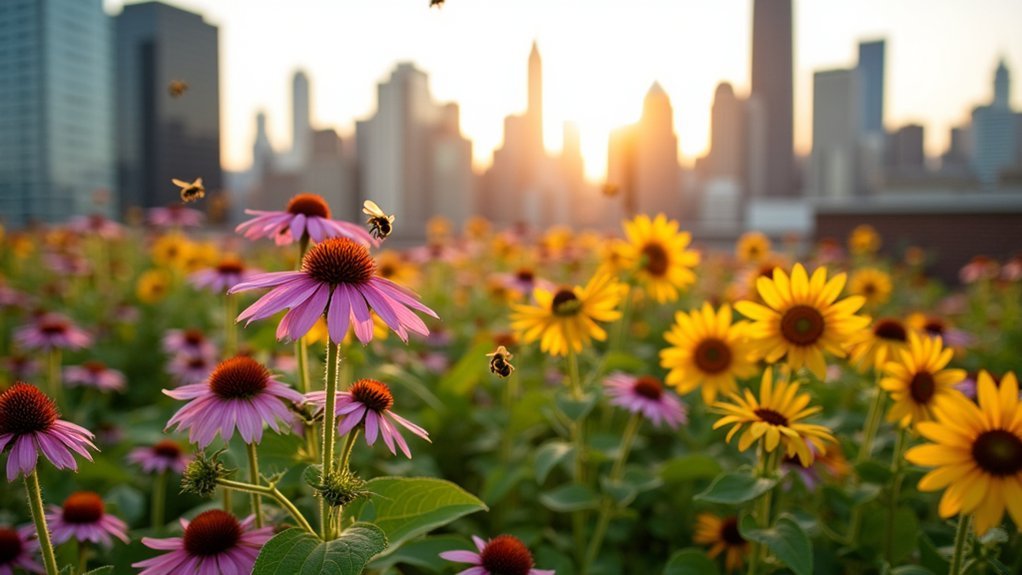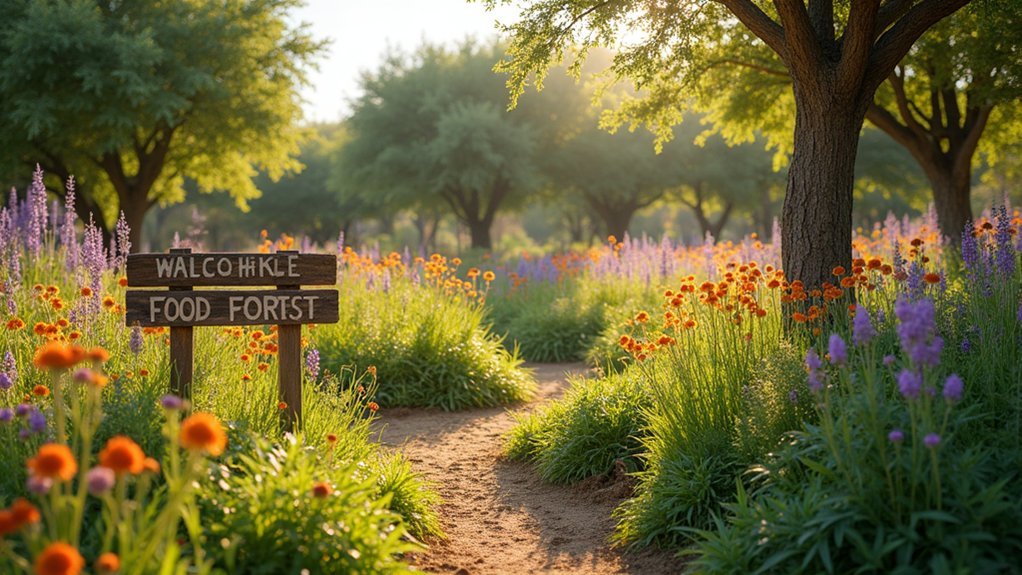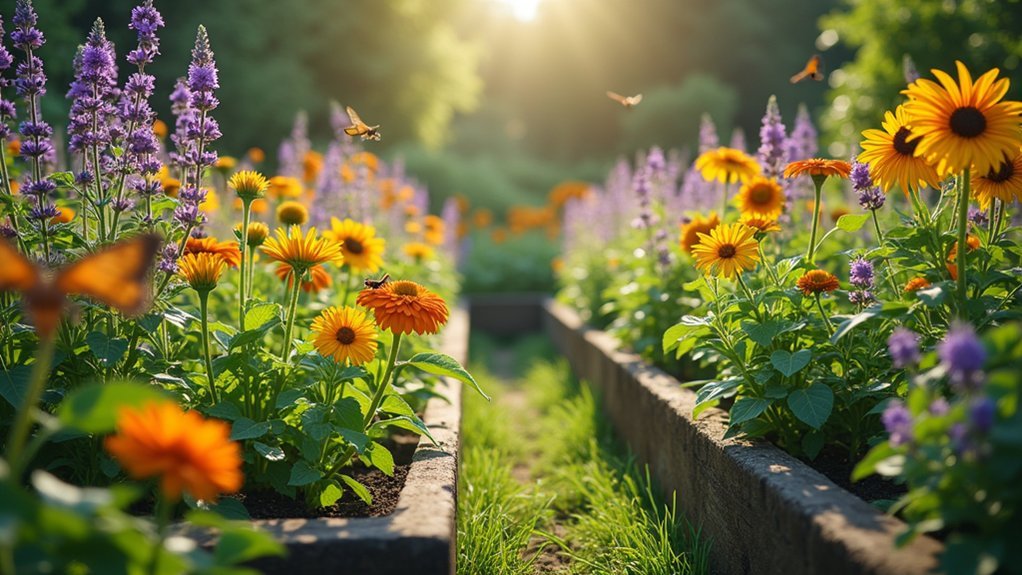America's top pollinator food gardens showcase innovative urban sustainability across the country. You'll find Houston's Butterfly Center garden functioning as a living laboratory, San Francisco's community-led nectar trails, and Portland's edible meadows buzzing with bees. Chicago offers rooftop honey havens, while Austin, Seattle, and Minneapolis feature drought-resistant prairies, year-round blooms, and heritage seed initiatives respectively. These vibrant spaces demonstrate how ecological benefits and fresh produce can flourish together in surprising locations.
10 Must-See Public Food Gardens For Pollinators

Oases of biodiversity, public food gardens designed for pollinators offer stunning visual displays while serving a vital ecological purpose. These vibrant spaces feature diverse flowering plants that bloom across seasons, ensuring bees, butterflies, and other beneficial insects have consistent food sources.
You'll find exceptional pollinator gardens in urban environments, where rooftop installations and community plots create important habitats amid concrete landscapes. These gardens primarily showcase native plants, which thrive with minimal maintenance while supporting local pollinator species.
When visiting these gardens, you'll often encounter educational programs that highlight sustainable gardening practices and the essential role pollinators play in our food systems.
These green sanctuaries combat habitat loss while providing fresh produce for communities—proving that beauty and functionality can brilliantly coexist in public spaces.
The Butterfly Effect: Houston Museum's Community Science Garden
Tucked beside the renowned Cockrell Butterfly Center, Houston's Community Science Garden stands as a living laboratory where ecology and education beautifully intersect.
You'll discover a thoughtfully designed Pollinator Garden showcasing diverse nectar and host plants that sustain local butterflies and bees throughout their life cycles.
This innovative space invites your participation in citizen science projects that monitor pollinator populations while demonstrating how native plants support biodiversity in urban settings.
As you explore, you'll learn why these pollinators and native plants form essential relationships that maintain our ecosystem's health.
The garden exemplifies how urban green spaces can thrive with minimal resources—once established, these native plants require less water and maintenance while maximizing ecological benefits.
Native plants transform urban spaces into resilient ecosystems that do more with less while nurturing biodiversity.
Visit to witness sustainable conservation practices that you can adapt to your own backyard.
Urban Nectar Trails: San Francisco's Pollinator Pathway Project

You'll find San Francisco's Pollinator Pathway Project creating crucial connections between fragmented urban habitats through strategically planted native flowering species.
These urban nectar trails rely on community-led initiatives where residents actively participate in planting and maintaining pollinator-friendly gardens throughout public spaces.
Connecting Fragmented Habitats
While urban environments often present challenges for wildlife, San Francisco's Pollinator Pathway Project offers an innovative solution by creating continuous "nectar trails" throughout the city.
These interconnected green spaces transform isolated pocket gardens into a coherent network, providing reliable habitat for native pollinators.
You'll find these pathways strategically designed to bridge gaps between parks, community gardens, and private yards. By planting pollinator-friendly native species along these routes, the project guarantees bees, butterflies, and hummingbirds can access food and shelter year-round.
The brilliance of this approach lies in its community-driven nature. Residents participate by converting portions of their yards into pollinator havens, effectively extending the city's green infrastructure.
This collective effort combats habitat fragmentation while building stronger community bonds through shared environmental stewardship.
Community-Led Planting Initiatives
Everyday citizens form the backbone of San Francisco's Urban Nectar Trails initiative, transforming barren urban spaces into vibrant pollinator havens. You'll find neighbors collaborating to create connected pathways of pollinator-friendly gardens throughout the city.
| Activity | Benefit |
|---|---|
| Planting native plants | Requires minimal water and maintenance |
| Attending workshops | Builds expertise in habitat creation |
| Creating garden networks | Connects fragmented ecosystems |
| Using local flora | Provides familiar food for native species |
| Sharing resources | Strengthens community bonds |
The project empowers you to become an environmental steward through sustainable gardening practices. By cultivating native plants in your yard or community space, you're directly supporting local pollinator populations. These community-led efforts collectively enhance urban biodiversity while improving food security and ecological health across San Francisco's neighborhoods.
Edible Meadows: Portland's Berry & Herb Collective Gardens
Portland's Edible Meadows transform urban spaces into Wild Berry Buffet Gardens where you'll find blackberries, blueberries, and native huckleberries providing vital nutrition for hungry pollinators.
You can wander through Urban Herb Foraging Paths lined with oregano, thyme, and lavender that buzz with bees collecting essential nectar and pollen.
These community-managed gardens connect you directly to food production while supporting pollinator populations through strategic planting of flowering edibles that bloom throughout the growing season.
Wild Berry Buffet Gardens
As the sun rises over the vibrant Wild Berry Buffet Gardens, both humans and pollinators gather to enjoy nature's sweetest offerings.
You'll discover a carefully orchestrated ecosystem where pollinators include bees, butterflies, and other beneficial insects that thrive among the diverse nectar plants.
When you visit these urban oases within Portland's Berry & Herb Collective, you'll appreciate how they're designed to:
- Provide continuous blooming throughout the growing season
- Feature native berries like blackberries and blueberries
- Support vital biodiversity in the urban environment
- Teach sustainable gardening practices to community members
You're welcome to participate in community activities where you'll learn how these gardens strengthen local food production while creating healthier habitats for our essential pollinator friends.
Urban Herb Foraging Paths
Beyond the berry buffets lie the Urban Herb Foraging Paths, where Portland's residents can meander through carefully designed edible meadows.
These accessible spaces invite you to harvest fresh herbs and seasonal berries while supporting critical pollinator populations in your city.
The paths feature diverse native and perennial plants that bloom in carefully planned succession, ensuring continuous food sources throughout the growing season for both you and local pollinators.
You'll notice the absence of pesticides—the Collective embraces organic practices to protect bees and butterflies that call these gardens home.
As you explore these urban oases, you're participating in a community-centered approach to urban biodiversity.
Educational programs help you identify edible plants and understand how your foraging activities contribute to a healthier ecosystem for all.
Rooftop Honey Havens: Chicago's Skyline Pollinator Network

Chicago's urban landscape has transformed into a buzzing ecosystem through its innovative Skyline Pollinator Network. You'll find over 500 connected rooftops creating vital habitats for honeybees and butterflies right above the bustling city streets.
These elevated gardens feature:
- Native plants specifically chosen to thrive in Chicago's climate conditions
- Sustainable spaces requiring minimal irrigation while maximizing pollinator support
- Active beekeeping operations producing local honey for community consumption
- Important foraging areas that greatly enhance urban biodiversity
Even in one of America's densest cities, these rooftop havens demonstrate how urban spaces can contribute to ecological health.
As you explore Chicago, remember that above you exists a thriving network where pollinators find food and shelter, proving that conservation and city life can successfully coexist.
Desert Bloom: Phoenix's Native Cactus & Succulent Foodscapes
While many cities struggle to maintain green spaces in harsh climates, Phoenix has embraced its desert identity through the innovative Desert Bloom initiative.
These native gardens showcase drought-resistant cacti and succulents that thrive in the Sonoran Desert while requiring minimal irrigation once established.
You'll discover how these pollinator-friendly landscapes create vibrant ecosystems where bees and butterflies gather nectar from flowering saguaro and prickly pear cacti throughout the blooming season.
The gardens serve as living classrooms where you can learn about biodiversity conservation and sustainable gardening practices.
Experience nature's classroom where desert wisdom and sustainable techniques flourish right in the heart of the city.
Join workshops and volunteer opportunities to help enhance these urban green spaces.
Coastal Prairie Revival: Austin's Drought-Resistant Food Forests

You'll find Austin's food forest pioneers transforming urban spaces with native Texas plants like American beautyberry, flame acanthus, and prairie verbena that historically thrived in coastal prairies.
These resilient plant communities create natural habitats while producing edible harvests through strategic layering of trees, shrubs, and ground covers.
Native Plant Pioneers
Deep in the heart of Texas, Austin's Coastal Prairie Revival stands as a demonstration of ecological innovation through its drought-resistant food forests.
You'll find these gardens blend sustainability with functionality, showcasing native plants that support the essential pollination process while requiring minimal water.
These pioneering gardens feature:
- Native fruit trees and vegetables that provide food for both humans and pollinators
- Drought-resistant species adapted to local climate conditions
- Permaculture designs that maximize ecological benefits
- Community engagement spaces that educate visitors about conservation
Mulch & Moisture Magic
The secret to Austin's Coastal Prairie Revival success lies beneath the surface in its innovative water conservation strategies.
You'll find expansive food forests where mulch serves as the cornerstone of drought resistance, creating a remarkable moisture-retention system that notably enhances plant health during Texas dry spells.
As you explore these gardens, notice how thick mulch layers minimize evaporation from soil water sources while gradually breaking down to enrich the earth beneath.
This clever technique supports diverse plant layers that create protective microclimates for both vegetation and visiting pollinators. Native species thrive with minimal irrigation once established, demonstrating sustainable gardening at its finest.
Community gardeners actively maintain these pollinator havens, learning firsthand how thoughtful mulching practices contribute to urban biodiversity while conserving precious water resources.
Seasonal Cycles: Seattle's Year-Round Pollinator Buffet
While many cities experience seasonal gaps in pollinator support, Seattle's public food gardens stand out for their continuous blooming strategy throughout the calendar year.
Seattle's innovative garden design creates an unbroken chain of pollinator support, defying seasonal limitations common in urban environments.
You'll find these gardens meticulously designed to sync with local pollinators' life cycles, ensuring they always have access to food sources.
The year-round buffet includes:
- Spring awakening – Early-blooming fruit trees and wildflowers nourish the first emerging pollinators
- Summer abundance – Sunflowers, squash, and diverse native plant species create nectar-rich feeding grounds
- Fall shift – Late-season bloomers bridge the critical gap when many gardens decline
- Winter sustenance – Specialized cold-weather plants provide rare winter forage
Heritage Seeds: Minneapolis Indigenous Food Sovereignty Gardens

Minneapolis's Heritage Seeds initiative represents a powerful blend of ecological wisdom and cultural preservation. When you visit these Indigenous food sovereignty gardens, you'll discover native plants and traditional crops that provide food sources for both communities and pollinators alike.
These gardens feature diverse flowering species that attract bees, butterflies, and beneficial insects throughout the growing season. Beyond their ecological value, they serve as living classrooms where you can learn about sustainable gardening practices and Indigenous food traditions.
The initiative's commitment to biodiversity does more than just revitalize urban green spaces—it reconnects people with cultural heritage while addressing food security concerns.
Community Cultivation: Boston's Neighborhood Foraging Initiative
Throughout Boston's diverse neighborhoods, public spaces have been transformed into vibrant food gardens where you'll find residents actively cultivating native plants and edible species.
This innovative program encourages you to harvest local food while providing essential food and shelter for native bees and other pollinators.
The initiative's impact extends beyond just gardening:
- Underutilized spaces become productive pollinator havens
- Community workshops teach pollinator-friendly gardening techniques
- Urban biodiversity increases through native plant cultivation
- Food accessibility improves across neighborhoods
Frequently Asked Questions
What Is the Best Location for a Pollinator Garden?
You'll want a spot with at least six hours of full sun daily. Choose well-drained soil, locate near existing pollinator habitats, include water sources, and design with varied plant heights for diverse microhabitats.
What Are the Best Pollinator Plants for Gardens?
Plant native species like milkweed, coneflower, and black-eyed Susan in your garden. You'll attract more bees and butterflies by including plants that bloom at different times throughout the seasons. Avoid using harmful chemicals.
What Is the #1 Pollinator?
While honeybees are often considered the #1 pollinator due to their $40 billion contribution to agriculture, you'll find they're essential for pollinating about one-third of your food, including fruits, vegetables and nuts.
What Vegetable Gardens Are Bee Friendly?
Your bee-friendly vegetable garden should include flowering crops like tomatoes, squash, and cucumbers, plus herbs such as basil and rosemary. Don't use pesticides and provide water sources with shallow, pebble-filled dishes.
In Summary
You've discovered how these remarkable public food gardens aren't just beautiful spaces—they're essential habitats supporting our pollinators and food systems. Whether you're admiring butterflies in Houston or harvesting berries in Portland, you're witnessing ecological design in action. Visit these gardens to connect with nature, learn sustainable practices, and see firsthand how pollinator conservation transforms urban environments into thriving, productive ecosystems for all.





Leave a Reply